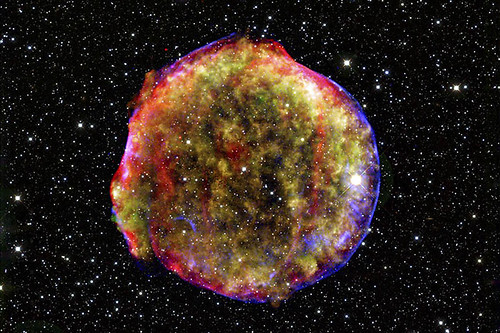Even Spherical Cows Have Udders
- By Koji Mukai
- February 11, 2011
- 1 Comment
In astrophysics, we often use the term “standard candle.” It is a highly useful, yet also very dangerous, term.
The danger is that outsiders – the press, the general public, and even some scientists who are not intimately familiar with this particular subject – see this term and take it too literally. As an analogy, take the spherical cow, which has become a symbol of simplifying assumptions. Such assumptions make back-of-the envelope calculations possible. But a “spherical” cow is an approximation – if someone forgets this and says “since cows are spherical, they can’t have features like udders,” you would laugh him off. In less extreme and more common cases, people may forget to check the difference between the volume of a spherical cow and that of actual cows with a head, a tail, four legs, and udders. Some other people may ignore the fact that the volume of a real cow is not a unique function of its height. I have noticed a similar type of sloppiness regarding “standard” candles.
![A cow [15/365]](http://farm3.static.flickr.com/2058/1846375599_cec42383dd.jpg)
Image Credit: Dave Wild (publicenergy)
It is notoriously difficult to measure the distances to stars and galaxies. Wouldn’t it be great if there was a class of objects that all had exactly the same intrinsic brightness? If a member of that class is twice as further away, it will appear 4 times fainter; thrice as far, 9 times fainter. By measuring the apparent brightness, then, we can invert that to infer the distance to that object. Standard candles is the shorthand for this idea of “a class of objects all of the same intrinsic brightness.”
In reality, though, no two astronomical objects are identical. The situation is very different in laboratories on Earth. We know that two electrons have exactly the same mass, exactly the same charge, and exactly the same magnetic moment. Stars are not like that. If you believe that there is a class of celestial objects that are identical to the same degree electrons are, I’ve got a bridge to sell you.
The most famous standard candle is the Cepheid variable. Its use started with Miss Leavitt’s discovery that the brighter Cepheids in the Small Magellanic Clouds (SMC) have longer period. Since all the stars in the SMC can be taken to be at the same distance, this implies that longer period Cepheids are intrinsically brigher. So, what astronomers really say is not that the true brightness of all the Cepheids are the same, but knowing the period of one allows us to estimate its true brightness. They are “standardizeable” candles, rather than standard candles, so to speak.
But the story doesn’t end there. When Edwin Hubble used the Cepheids to estimate the distance to the Andromeda galaxy, he got it wrong, because astronomers of the time didn’t realize there were actually two types of Cepheids. Even after taking that effect into account, we have to worry about the subtler effect from different chemical compositions among the Cepheids. That is, the degree to which Cepheids can be considered “standard” is a constant research topic, improving over time but never reaching a single, absolutely accurate value.

NGC 4603, the most distant galaxy in which a special class of pulsating stars called Cepheid variables have been found. Credit: Jeffrey Newman (Univ. of California at Berkeley) and NASA
Another famous example is the Type Ia supernovae. They used to be an okay standard candle 20 years ago: They sort of worked, if you cared about distances with an accuracy of a factor of 2 (don’t laugh, that’s pretty good in astronomy). [Editor’s note: Maggie had a college astronomy professor who once said, “What’s a factor of 10 between friends?”] Then Mark Phillips discovered a wonderful relationship between the peak brightness and the time it takes for a supernova becomes fainter. When you take this factor into account (variously known as “Phillips correction” or “stretch factor”), these supernovae become a much better standard candle. Since they are bright and can be observed from long distances, Type Ia supernovae have become widely used as a tool for cosmological research.

Image of remnant from the type Ia Tycho supernova: X-ray: NASA/CXC/SAO, Infrared: NASA/JPL-Caltech; Optical: MPIA, Calar Alto, O.Krause et al.
Given the history of standard candles in astronomy, it’s a sure bet that there are other factors that make them almost-but-not-quite-standard. The only question is how bad, and if we can identify the specific factors involved and therefore correct for them.
So, the next time you see a press release say “standard candles”, remember that even spherical cows have udders.
Want to read more?
- Cosmic Times – 1955 Edition: “Yardsticks” in Neighbor Galaxy Double Universe’s Size”
- The Cosmic Distance Scale – in particular the information page on the Milky Way Galaxy talks about using Cepheid Variables to calculate distances.
- Imagine the Universe’s section on Cepheid Variables
- A technical poster about Type Ia supernovae



[…] This post was mentioned on Twitter by NASA Blueshift and Webb Telescope, Lovely Rita. Lovely Rita said: RT @NASAblueshift: New post from Blueshift's guest blogger Koji – "Even Spherical Cows Have Udders." Intrigued? http://bit.ly/hypbo6 […]